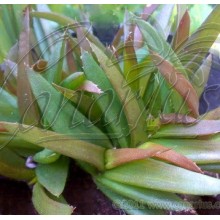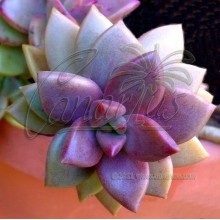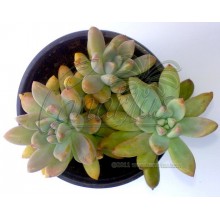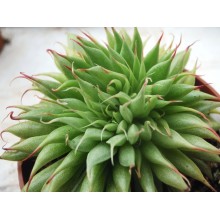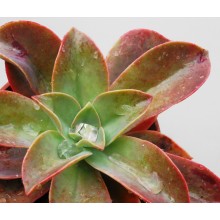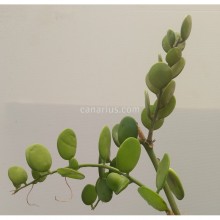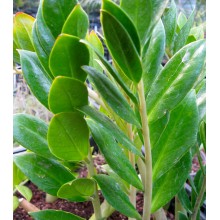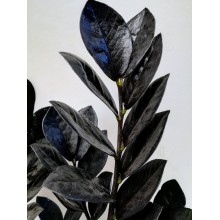Succulents There are 628 products.

World deserts and dry areas are home to the most interesting plants. Canarius offers an increasing selection of succulent plants of maximum quality, because they are grown outdoors, under the full sun of the Canary Islands.
Succulents or "fat plants" are water-retaining species, adapted to dry conditions. They store succum (juice, water) in their leaves, stems or roots, and often show a stout and fleshy appearance.
Subcategories
-
Agave
Agave is a genus of succulent plants from America. Some species grow in cold areas and take hard frost, while some others live in tropical climates. Some are tiny dwarfs and some are giants, up to 2 or 3 m wide.
Cold hardy agaves can create an exotic effect in your garden. Agave species make fine companions to palms or cacti. Variegated agaves are incredibly sought after by collectors. Our web shop offers an ever changing selection of species. We ship bare rooted plants, unless otherwise specified.
-
Aloe, Gasteria & Haworthia
Aloe, Gasteria and Haworthia are three related genera, comprising hundreds of succulent plants. They are all easily grown in pots. A few adapt to low-light levels of indoor conditions and can be grown as house plants.
- Aloe is a genus of about 400 species, native to Africa, Arabia and Madagascar. Small or dwarf aloes are becoming especially popular in colder climates as they can be taken indoors during the hardest months.
- Gasteria includes some 80 species endemic to South Africa, known for their spectacular leaves which are glossy, mottled and textured. They bloom in Spring-Summer with long spikes of small orange flowers. Some species are so variable that we offer particular clones from specific locations.
- Haworthia is a genus endemic to South Africa with about 70 species and a number of local subspecies, varieties and forms. Leaves are often banded, speckled, dotted, or semi-translucent and show wide variations.
-
Crassulaceae
This is a new, growing section of species from the family Crassulaceae. There are about 1,400 species in 33 genera and their distribution is worldwide, but mostly occur in the Northern Hemisphere and Southern Africa, especially in dry habitats. Here you can buy healthy, sun-hardened plants grown in the Canary Islands and shipped to your home.
-
Mesembs
This group of desert plants is briefly named Mesembs because they belong to a botanical family formerly named Mesembryanthemaceae. There are almost 2.000 species, mainly found in Southern Africa, with extreme adaptations to dry habitats. Some are called "living stones", as they look like pebbles. Many are easy to grow and their main need is full sun. Some are difficult because they grow in truly extreme areas.
Our Web Shop offers sun grown healthy plants, with compact and colourful leaves. Some plants are sold as cuttings, and others as rooted plants, of at least two years old.
-
Sansevieria
Recently assigned to the family Asparagaceae, the genus Sansevieria counts about 70 species, nearly all native to Africa, Arabia and Madagascar. Perennial herbs adapted to dry habitats with stiff, succulent leaves, their length ranges from a few centimeters to 2 meters. Sansevieria trifasciata and its many cultivars are among the most popular houseplants, popularly called mother in law's tongue. A well grown plant usually produces a spike of many white, richly scented flowers and then orange berries. Even the rarest species are resistant to neglect, provided you keep them from frost in winter and scorching sun in summer.
-
Hoya
Hoyas are twining vines, with showy exotic flowers, from the rainforests in Asia and Oceania. Most species grow in bright shade or morning sun, but they will also grow indoors as house plants. They are well suited for baskets, trellises or ladders. They tolerate a few weeks of drought but they are sensitive to frost and cold. Many hoyas are easy to grow and bloom, while some are tricky and rare.
-
Asclepiads
Asclepiads or Asclepiadoideae are a subfamily in the Apocynaceae, with about 2900 species. There are lots of leafless stem succulents but also perennial herbs, shrubs, lianas or rarely trees. They produce remarkable flowers, for the complex mechanisms they have developed for pollination. Many species produce an unusual fragrance, often called "carrion", and attracts flies for pollination. -
Caudiciforms
These plants from dry areas produce an unusually thick stem, the caudex. They are also called pachycauls and they have a disproportionately thick trunk, often with few branches. The caudex can be hidden underground, but in most cases they grow upwards, forming spectacular trees. The largest caudiciforms in the world are the baobabs. -
Other succulents
Here you will find all those species of desert plants that are not included in their own category. We will place here all plants from unusual families, other than Agaves, Aloes, Crassulaceae, Sansevieria, Mesembs, Epiphytic cacti, etc.
-
x Alworthia 'Black Gem'
x Alworthia 'Black Gem'
NEW ! - Cont. =10 cm. Old inter-generic hybrid of Haworthia cymbiformis and Aloe speciosa, The foliage is green-red-brown, and intensifies during summer to almost black. Protect from frost.
10,50 € -
x Graptosedum Bronze
x Graptosedum Bronze
Pack of three cuttings. This compact succulent spreads slowly, rooting occasionally along stems. Leaf colour is jade-purple to chocolate. It is mat-forming so it is excellent in desert beds or in a potted combination of succulent plants.
10,60 € -
x Graptosedum Francesco Baldi
x Graptosedum Francesco Baldi
Beautiful hanging hybrid with pinkish fleshy leaves, obtained by crossing Graptopetalum paraguayense and Sedum pachyphyllum.
10,40 € -
x Graptoveria 'Silver Star'
x Graptoveria 'Silver Star'
NEW ! - Silvery rosettes of unusual tapering leaves, with a shape reminiscent of sempervivums.
10,40 € -
x Graptoveria cv. Douglas Huth
x Graptoveria cv. Douglas Huth
This is one of the largest graptoverias, about 20 cm in diameter. This plants branches freely and has some nice leaf colours, changing through the seasons.
10,30 € -
Xerosicyos danguyi
Xerosicyos danguyi
This plant is popular and easy in cultivation. Stems and leaves are grey-silvery and each leaf resembles a coin. A few spiralling tendrils are produced here and there.
16,30 € -
Zamioculcas zamiifolia
Zamioculcas zamiifolia
This aroid from semi-dry areas is named so because of the similarity with some cycads in the genus Zamia. It is native to E - SE Africa, that resists to many different conditions. Its showy glossy leaves are produced from a stout underground, succulent rhizome. It is very easy to grow, and the unusual flowers are a nice addition.It is normally evergreen,...
12,40 € -
Zamioculcas zamiifolia 'Raven's Black'
Zamioculcas zamiifolia 'Raven's Black'
Black leaved cultivar of the now-popular Zamioculcas: an unusual cycad-looking aroid from South Africa. The green type of this species was considered rare until the 1990's when it was mass-propagated to be grown as a houseplant.
28,20 €
At the moment there are few products in this category Succulents

























